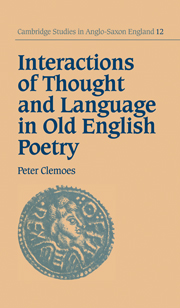Book contents
- Frontmatter
- Contents
- Illustrations
- Preface
- Abbreviations
- PART I The poetry of an aristocratic warrior society
- 1 The chronological implications of the bond between kingship in Beowulf and kingship in practice
- 2 Society's ancient conceptions of active being and narrative living
- 3 Poetry's tradition of symbolic expression
- 4 The language of symbolic expression
- 5 Types of symbolic narrative
- 6 Basic characteristics of symbolic story
- PART II The poetry of a universal religion
- Works cited
- Index I Quotations of two or more ‘lines’ of Old English poetry
- Index II A representative selection of the symbols and word pairs cited in discussion
- Index III General
3 - Poetry's tradition of symbolic expression
Published online by Cambridge University Press: 18 December 2009
- Frontmatter
- Contents
- Illustrations
- Preface
- Abbreviations
- PART I The poetry of an aristocratic warrior society
- 1 The chronological implications of the bond between kingship in Beowulf and kingship in practice
- 2 Society's ancient conceptions of active being and narrative living
- 3 Poetry's tradition of symbolic expression
- 4 The language of symbolic expression
- 5 Types of symbolic narrative
- 6 Basic characteristics of symbolic story
- PART II The poetry of a universal religion
- Works cited
- Index I Quotations of two or more ‘lines’ of Old English poetry
- Index II A representative selection of the symbols and word pairs cited in discussion
- Index III General
Summary
Poetry's function was not only to register the progression from active being to narrative living but also to impart form to that key process. It shared society's instinct to see in the experience conditioned by the continuum of time a pattern leading up to and including the present. The simplest treatment society could give to this continuity was to plot it by listing like following like, as in genealogies or regnal lists, but the urge to go further by using a more sophisticated method was strong, as we can see from the brilliant innovation in graphic presentation introduced in the manuscripts of the Anglo-Saxon Chronicle circulated c. 890. Thanks to new scribal technique their continuous series of year numbers, most of them each glossed with its related event or events, formed a visible chain, at one end connected to Christ's birth in the reign of Octavian but at the other still being forged in the fiery dangers of the reign of Alfred. A strong impression was given that the actions of the present, however perilous, were anchored in a secure and illustrious origin. The numerical cable stretching out from the past into the present offered social and political reassurance; it was a token of underlying stability. Written record was meeting an ancient need in a modern way.
Vernacular poetry's tradition of eliciting pattern, however, was to set events in an indefinite environment of all time and space, whether the occurrences belonged to the past or the present, were far away or near at hand, as can readily be illustrated from verse's shaping of narrative itself.
- Type
- Chapter
- Information
- Interactions of Thought and Language in Old English Poetry , pp. 117 - 133Publisher: Cambridge University PressPrint publication year: 1995

